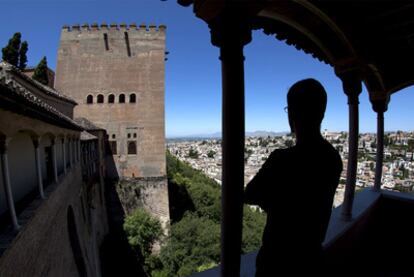Opening up the Alhambra's secret spaces
Passages, towers, dungeons, stairways... the hidden "underbelly" of Spain's most-visited monument is set to be revealed with the help of new interactive technology
Lost in the nooks and crannies that lead into the Arab baths of the Comares Palace where the star-shaped skylights that pepper the stone vaults let in the sun's rays like golden rain and, above all, the silence of the centuries is encrusted among the myrtles and waterways, you find the most intoxicating part of the Alhambra.
It is also the least conventional, off limits to the majority of the millions of mortals (three million a year, to be exact) who ascend the Sabika hill to contemplate Spain's most-visited monument. These are mysterious places that lie in the underbelly of the Nasrid palaces, forbidden or tightly restricted owing to the problems of preservation or of access that now, thanks to a thousand-and-one new technologies, can be visited by tourists from all over the world.
"It will let you modify the colored ceilings rubbed out by the centuries"
Sorry, that should really be 'visited,' in inverted commas, as we are not talking flesh-and-blood visits here. Access to the Alhambra's forbidden areas will arrive in the form of a project that will allow people to enter its hidden paradises in a virtual way. Set to be ready in around a year, La Alhambra oculta (The hidden Alhambra) will use latest-generation interactive guides (the models are yet to be defined but it's possible they could look like an iPod that visitors will wear around their necks) to situate you in front of the doors or windows of those large, shut-up rooms and virtually recreate them. It will also allow you to play with them: to reconstruct, for example, the multicolored coffered ceilings rubbed out by the passing of the centuries and modify them as you fancy, or change the fascinating geometric shapes of the tiles made by the sultan's craftsmen.
An agreement between the board of the Alhambra and Generalife, the non-profit World Monuments Fund (WMF) and the American Express Foundation forms the backdrop to this sustainable tourism project that aims not just to reinforce and improve the possibilities of enjoying the monument, but also to release the pressure put on by around 9,000 daily visits. Other ways of visiting, other ways of seeing and other ways of understanding history: and above all, the ambition, as Alhambra board director María del Mar Villafranca recognizes, "to capture young audiences with a novel project that will let them enjoy currently unvisited areas, making them more accessible through new technology."
The American Express Foundation is investing $200,000 in La Alhambra oculta, while the New York-based WMF will bring another $300,000, to be matched by the Alhambra board, for the restoration of one of those jewels that until now could not be visited because of its bad state of repair: the Partal Oratory.
But back to the Alhambra and its mysteries. Today, when the sun overwhelms the hill on which the old red castle of the Nasrid monarchs rises, you're thankful for the cool offered by hidden shady spots. Spots such as those that surround the Torre de las Damas, a wonder built by the highly gifted 14th-century masons along the wall that surrounds the Alhambra complex - and closed to visitors.
As soon as you go through the gate, it is easy to notice how the air passes through and the suffocating heat is turned into conditioned air in a natural way: it is clear that, as well as being in love with esthetics, the sultans and their architects were also highly pragmatic.
"This is where you find the only purple-colored tiles in the whole of the Alhambra," Villafranca explains proudly. She has held the reins on the board for the past seven years, generating headlines with the way she has preserved the splendor of the monument: the complex restoration of the Patio de los Leones and the recent discovery of painted anthropomorphic figures in the Mirador de Lindaraja.
One in the afternoon. The vertigo-inducing balcony of the Peinador de la Reina is another of the most captivating corners of the whole complex. However, it is also closed to the public because the access is so narrow. It is one more of those forbidden places of the hidden Alhambra. Passages, towers, dungeons, patios, stairways... A secret world set to stop being so thanks to technology.

Tu suscripción se está usando en otro dispositivo
¿Quieres añadir otro usuario a tu suscripción?
Si continúas leyendo en este dispositivo, no se podrá leer en el otro.
FlechaTu suscripción se está usando en otro dispositivo y solo puedes acceder a EL PAÍS desde un dispositivo a la vez.
Si quieres compartir tu cuenta, cambia tu suscripción a la modalidad Premium, así podrás añadir otro usuario. Cada uno accederá con su propia cuenta de email, lo que os permitirá personalizar vuestra experiencia en EL PAÍS.
¿Tienes una suscripción de empresa? Accede aquí para contratar más cuentas.
En el caso de no saber quién está usando tu cuenta, te recomendamos cambiar tu contraseña aquí.
Si decides continuar compartiendo tu cuenta, este mensaje se mostrará en tu dispositivo y en el de la otra persona que está usando tu cuenta de forma indefinida, afectando a tu experiencia de lectura. Puedes consultar aquí los términos y condiciones de la suscripción digital.








































